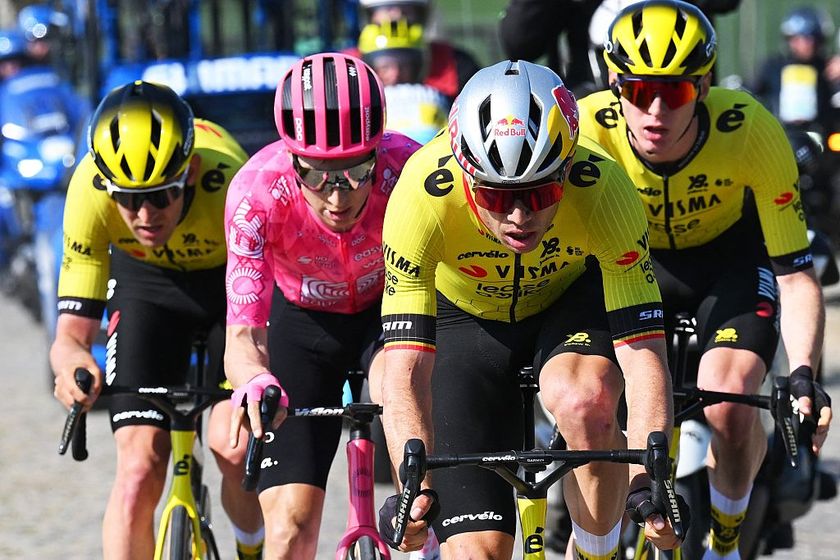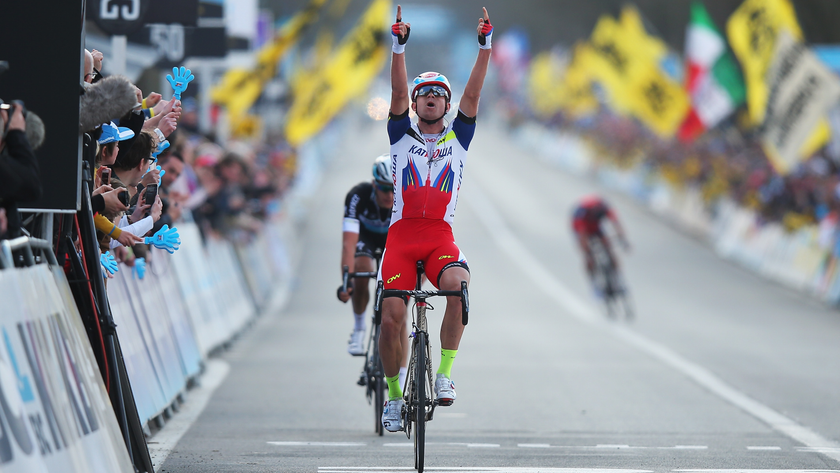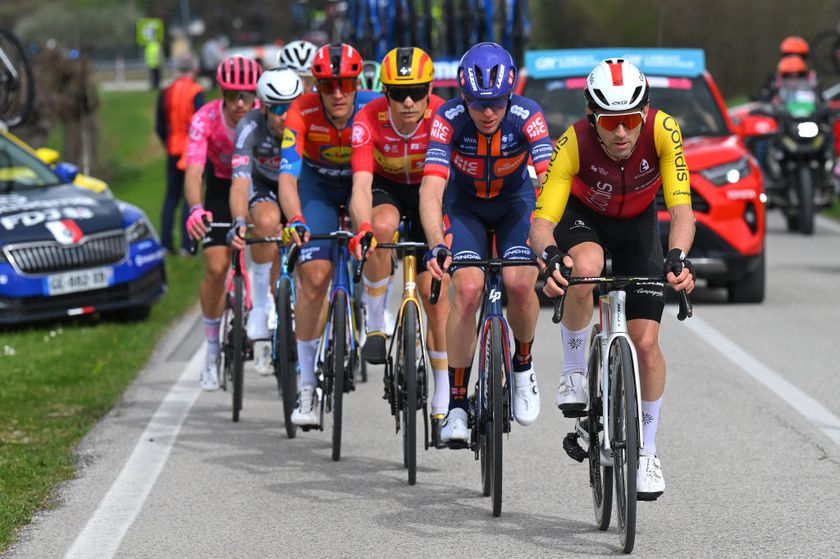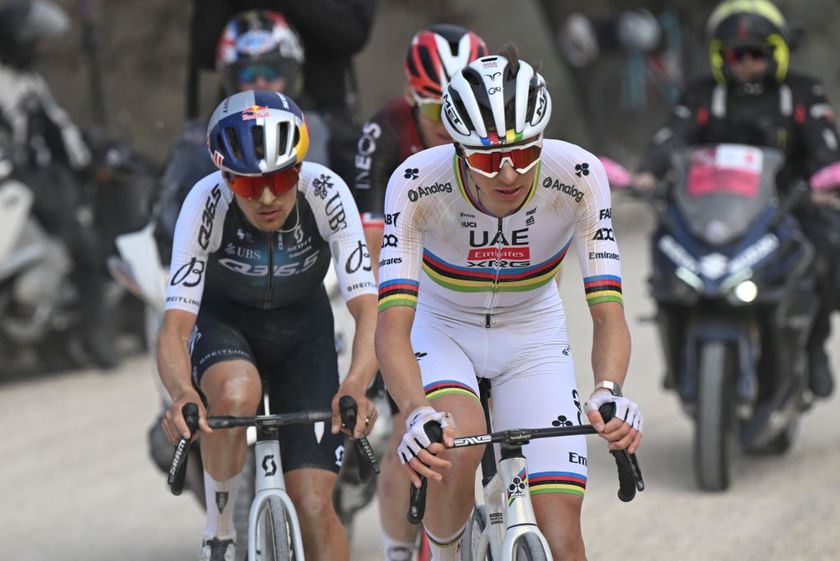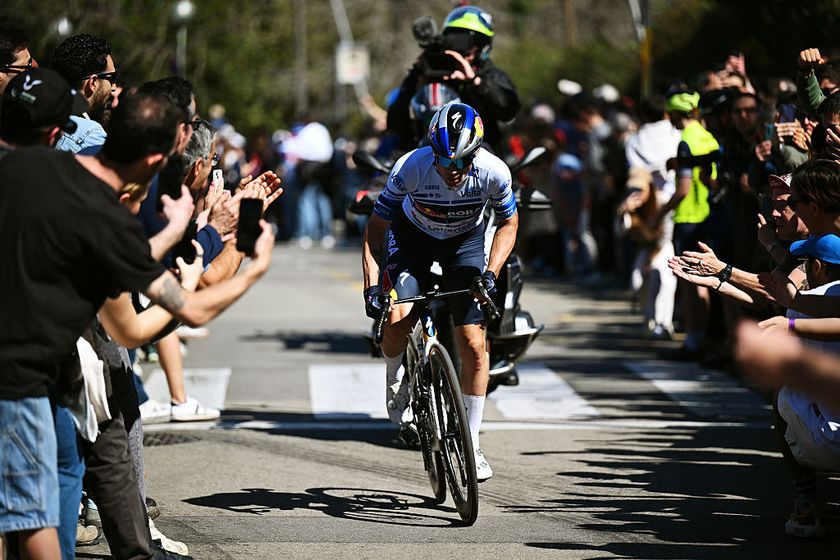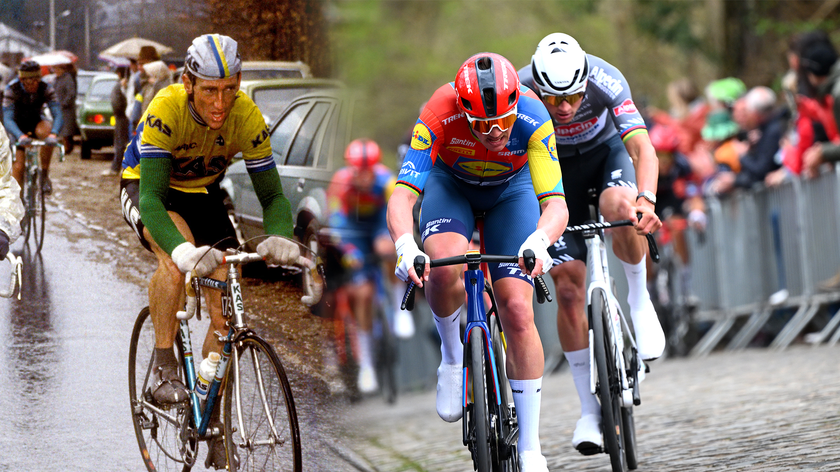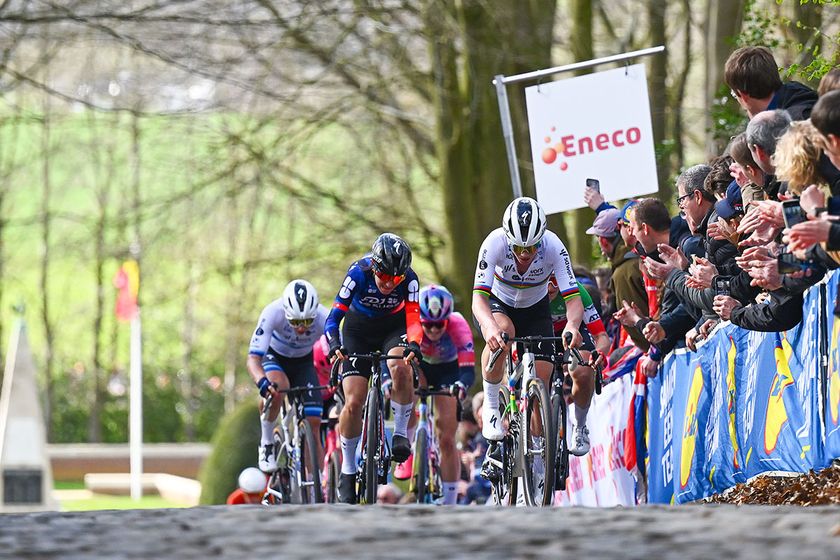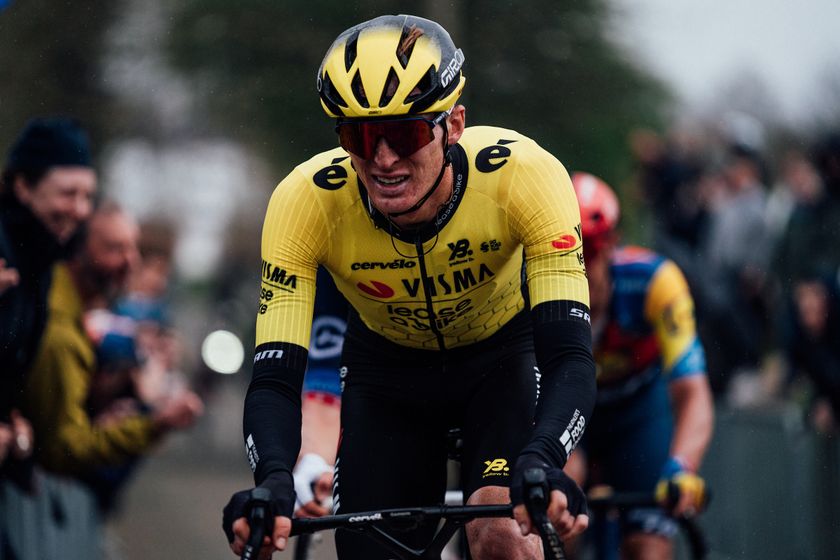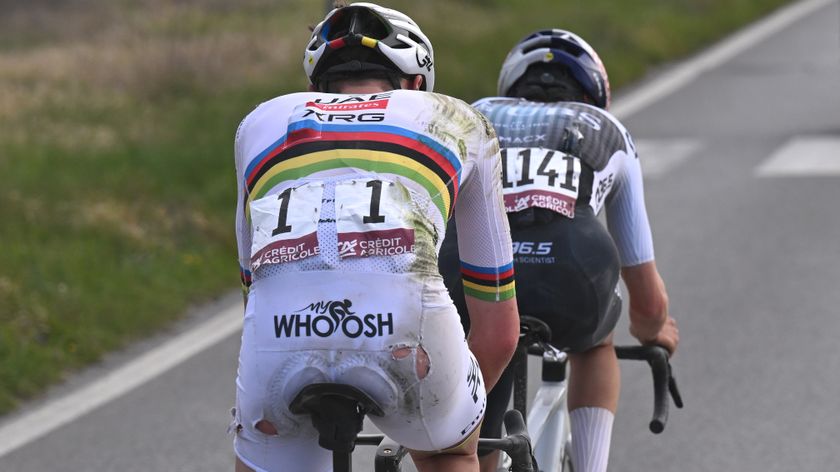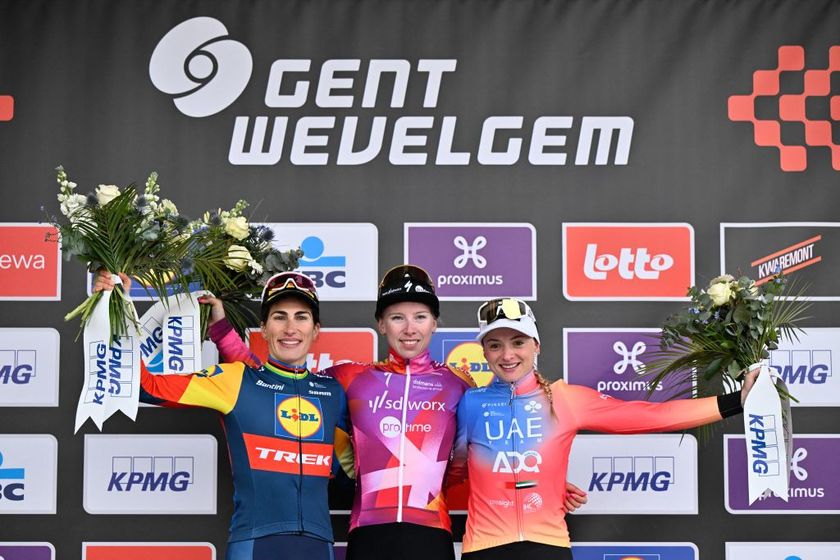Fitness questions and answers for May 9, 2005
Got a question about fitness, training, recovery from injury or a related subject? Drop us a line at...
Form & Fitness Q & A
Got a question about fitness, training, recovery from injury or a related subject? Drop us a line at fitness@cyclingnews.com. Please include as much information about yourself as possible, including your age, sex, and type of racing or riding. Due to the volume of questions we receive, we regret that we are unable to answer them all.
Carrie Cheadle, MA (www.carriecheadle.com) is a Sports Psychology consultant who has dedicated her career to helping athletes of all ages and abilities perform to their potential. Carrie specialises in working with cyclists, in disciplines ranging from track racing to mountain biking. She holds a bachelors degree in Psychology from Sonoma State University as well as a masters degree in Sport Psychology from John F. Kennedy University.
Dave Palese (www.davepalese.com) is a USA Cycling licensed coach and masters' class road racer with 16 years' race experience. He coaches racers and riders of all abilities from his home in southern Maine, USA, where he lives with his wife Sheryl, daughter Molly, and two cats, Miranda and Mu-Mu.
Kelby Bethards, MD received a Bachelor of Science in Electrical Engineering from Iowa State University (1994) before obtaining an M.D. from the University of Iowa College of Medicine in 2000. Has been a racing cyclist 'on and off' for 20 years, and when time allows, he races Cat 3 and 35+. He is a team physician for two local Ft Collins, CO, teams, and currently works Family Practice in multiple settings: rural, urgent care, inpatient and the like.
Fiona Lockhart (www.trainright.com) is a USA Cycling Expert Coach, and holds certifications from USA Weightlifting (Sports Performance Coach), the National Strength and Conditioning Association (Certified Strength and Conditioning Coach), and the National Academy for Sports Nutrition (Primary Sports Nutritionist). She is the Sports Science Editor for Carmichael Training Systems, and has been working in the strength and conditioning and endurance sports fields for over 10 years; she's also a competitive mountain biker.
Eddie Monnier (www.velo-fit.com) is a USA Cycling certified Elite Coach and a Category II racer. He holds undergraduate degrees in anthropology (with departmental honors) and philosophy from Emory University and an MBA from The Wharton School of Business.
Eddie is a proponent of training with power. He coaches cyclists (track, road and mountain bike) of all abilities and with wide ranging goals (with and without power meters). He uses internet tools to coach riders from any geography.
Get The Leadout Newsletter
The latest race content, interviews, features, reviews and expert buying guides, direct to your inbox!
David Fleckenstein, MPT (www.physiopt.com) is a physical therapist practicing in Boise, ID. His clients have included World and U.S. champions, Olympic athletes and numerous professional athletes. He received his B.S. in Biology/Genetics from Penn State and his Master's degree in Physical Therapy from Emory University. He specializes in manual medicine treatment and specific retraining of spine and joint stabilization musculature. He is a former Cat I road racer and Expert mountain biker.
Since 1986 Steve Hogg (www.cyclefitcentre.com) has owned and operated Pedal Pushers, a cycle shop specialising in rider positioning and custom bicycles. In that time he has positioned riders from all cycling disciplines and of all levels of ability with every concievable cycling problem.They include World and National champions at one end of the performance spectrum to amputees and people with disabilities at the other end.
Current riders that Steve has positioned include Davitamon-Lotto's Nick Gates, Discovery's Hayden Roulston, National Road Series champion, Jessica Ridder and National and State Time Trial champion, Peter Milostic.
Pamela Hinton has a bachelor's degree in Molecular Biology and a doctoral degree in Nutritional Sciences, both from the University of Wisconsin-Madison. She did postdoctoral training at Cornell University and is now an assistant professor of Nutritional Sciences at the University of Missouri-Columbia where she studies the effects of iron deficiency on adaptations to endurance training and the consequences of exercise-associated changes in menstrual function on bone health.
Pam was an All-American in track while at the UW. She started cycling competitively in 2003 and is the defending Missouri State Road Champion. Pam writes a nutrition column for Giana Roberge's Team Speed Queen Newsletter.
Dario Fredrick (www.wholeathlete.com) is an exercise physiologist and head coach for Whole Athlete™. He is a former category 1 & semi-pro MTB racer. Dario holds a masters degree in exercise science and a bachelors in sport psychology.
Scott Saifer (www.wenzelcoaching.com) has a Masters Degree in exercise physiology and sports psychology and has personally coached over 300 athletes of all levels in his 10 years of coaching with Wenzel Coaching.
Kendra Wenzel (www.wenzelcoaching.com) is a head coach with Wenzel Coaching with 17 years of racing and coaching experience and is coauthor of the book Bike Racing 101.
Steve Owens (www.coloradopremiertraining.com) is a USA Cycling certified coach, exercise physiologist and owner of Colorado Premier Training. Steve has worked with both the United States Olympic Committee and Guatemalan Olympic Committee as an Exercise Physiologist. He holds a B.S. in Exercise & Sports Science and currently works with multiple national champions, professionals and World Cup level cyclists.
Through his highly customized online training format, Steve and his handpicked team of coaches at Colorado Premier Training work with cyclists and multisport athletes around the world.
Brett Aitken (www.cycle2max.com) is a Sydney Olympic gold medalist. Born in Adelaide, Australia in 1971, Brett got into cycling through the cult sport of cycle speedway before crossing over into road and track racing. Since winning Olympic gold in the Madison with Scott McGrory, Brett has been working on his coaching business and his www.cycle2max.com website.
Richard Stern (www.cyclecoach.com) is Head Coach of Richard Stern Training, a Level 3 Coach with the Association of British Cycling Coaches, a Sports Scientist, and a writer. He has been professionally coaching cyclists and triathletes since 1998 at all levels from professional to recreational. He is a leading expert in coaching with power output and all power meters. Richard has been a competitive cyclist for 20 years
Andy Bloomer (www.cyclecoach.com) is an Associate Coach and sport scientist with Richard Stern Training. He is a member of the Association of British Cycling Coaches (ABCC) and a member of the British Association of Sport and Exercise Sciences (BASES). In his role as Exercise Physiologist at Staffordshire University Sports Performance Centre, he has conducted physiological testing and offered training and coaching advice to athletes from all sports for the past 4 years. Andy has been a competitive cyclist for many years.
Michael Smartt (www.cyclecoach.com) is an Associate Coach with Richard Stern Training. He holds a Masters degree in exercise physiology and is USA Cycling Expert Coach. Michael has been a competitive cyclist for over 10 years and has experience coaching road and off-road cyclists, triathletes and Paralympians.
Kim Morrow (www.elitefitcoach.com) has competed as a Professional Cyclist and Triathlete, is a certified USA Cycling Elite Coach, a 4-time U.S. Masters National Road Race Champion, and a Fitness Professional.
Her coaching group, eliteFITcoach, is based out of the Southeastern United States, although they coach athletes across North America. Kim also owns MyEnduranceCoach.com, a resource for cyclists, multisport athletes & endurance coaches around the globe, specializing in helping cycling and multisport athletes find a coach.
Arm length discrepancy
Fitting a new bike
Back-calculating power
Borderline cholesterol
Sodium phosphate
Saddle discomfort through structural imbalance
Achieving a high heart rate
Loose knee
Post-Tib pain and bike fit
Shoes and stress fractures
AHR
Cycling for fitness and pleasure
Hammertoe and cycling
Cycling with a fever
High heart rate
Arm length discrepancy
Hello, I'm a male cyclist of 46 years old with an arm length discrepancy. I ride mostly for pleasure with some cyclosports. The difference in length is approximately seven inches (the left is shorter); if I pull on my left arm I can reduce the length difference to about four inches. I would like any ideas on how to minimise the discomfort I have during a long ride.
I thought that one solution would be special handlebars, where the left side is modified in the appropriate way: the left side of the bar could drop almost immediately after a space for the brake lever so it should be easier to be resting on the brake hood. The drop should be longer on the left so I'm able to be in the drops easier. What do you think of this and do you know people or company that can make customised handlebars.
Michel Jalette
Montreal, Canada
I have in the past encountered people with similar issues though not as marked a difference as yours. I have investigated having custom handlebars made in the past for this purpose but there is not enough demand and I didn't have any luck with finding anyone who could make asymmetric bars at a reasonable price. Don't worry though as there is a solution.
Fitting a new bike
Hi all.
Here's my situation - I have the potential to get a Lemond at a very good price; the problem is that I can't sample one. So I have to base it on some information I currently understand. My previous bike was a Giant TCR1 (2003) size medium. The overall fit was barely small. It had a giant 110mm stem. I had it set to a positive rise and the distance from seat to bar was signifigant at 3.5"
I've demoed a Trek Madone 5.2, and in the 58cm size it felt amazing. Couldn't find any problems with fit, and the bike was set up pretty much neutral (seat fore/aft etc). My measurements are: 177.5cm tall, 146.5 to sternum, 85cm inseam, 44cm shoulders, 74cm arm reach, (give or take a bit, it's awkward to figure out). I'm 38 and a masters age racer at a weight of 165lbs. I'm looking for a 'do-it-all' bike. I race road/crit (as well at mtb/cross/track). My choice is between a 55 or 57cm Lemond Victorie 2005 bike. I guess I'd rather be a bit on the smaller size if I have to choose. I sat on a 53cm belonging to another racer this weekend, and it was simply too small. Any very quick input would be greatly appreciated!
Don Ricker
You have left out a lot of pertinent info, but given me something to go on. Given that you state the 58cm Trek Madone felt the best and reiterated that fact in your attachment, I will assume based on what you have told me that that is the ideal bike and position, or close to to it. The implications for the two Lemonds are as follows: Firstly, I would go back to the shop and measure the head tube length of the Trek Madone 58 cm frame. All of these frames will have similar bottom bracket drops and by buying the Lemond with the closest head tube length to the Trek you are getting a similar height frame in terms of front end height. If it is the 55 cm Lemond, the seat tube angle is the same and the top tube is 7mm shorter. This means that if you had the seat centred in the seat rail clamp of the seat post, you would need a stem 7mm longer set at the same relative height to have the bars in the same position relative to seat.
Back-calculating power
Is there a way to reverse calculate a racer's wattage average wattage distance, course profile, an individual's average speed, and pace, time? You could also make assumptions of their weight and efficiencies. The end game is I would like to find out the wattage of the winner, and then potentially train to that output for that amount of time. Thanks for your help,
Kenny Deemer
Lakewood, Colorado
Kenny,
Borderline cholesterol
I enjoy reading the fitness section for the insight into all things cycling. Your panel is very well rounded and their service much appreciated. Just received my CHO results form the Doc and it's a tad high. LDL is 146. HDL is good at 60. He's prescribed 500mg daily of niacin. I know the better type is Inositol Hexaniacinate. So I'll try that one. Will this affect my cycling in any way? Thanks for the forum.
Jon H
Arizona
Jon,
Sodium phosphate
Hey,
Any thoughts about sodium phosphate loading prior to a few races per season? Joe Friel has a bit on it in the Cyclist's Training Bible and it's sold as 'Race Day Boost' by e-caps.com. I recently tried it, but it's hard to know if it really made any difference. I've read some of the research and it seems pretty equivocal, but I wondered if you had any thoughts.
Steve Smith
Steve,
Saddle discomfort through structural imbalance
I am a 34 year old male who has been riding competitively for 15 years. I have trained in the gym for six years. The last couple of years I have been suffering from saddle discomfort and a really stiff neck. I have tried almost every saddle on the market to get comfortable and nothing has worked, even though the saddle has always been set up with correct fore/aft adjustment. The saddle height, bar and stem adjustments were also in the correct range.
The discomfort from the saddle always comes from the middle right hand side of the saddle edge. The right hand side of the saddle digs into my groin as opposed to the left side which does not. Its been observed that when I ride I don't sit in the middle of the saddle but more pushed out to the left hand side .The left hand side of my shoulder also looks like it's pushed up more, relative to my head. There is obviously some fundamental muscular imbalance going on. What action can I take?
Oliver Romov
I would gently take issue with your contention that you have been correctly set up. If you had been, you would not have the comfort issues that you speak of and/or would have been referred on to whatever type of health professional was deemed appropriate.
Achieving a high heart rate
I have been cycling for two years, mostly to train for Half Ironman triathlon distances. For the first time I have been incorporating interval sessions in my cycling program.
Last year I averaged 22 mph for the 56 mile bike leg of the 2 Half Ironman races I did on rolling courses. I would like to improve my speed on the bike and this is why I'm doing intervals. During running intervals of 1/2 mile to 1 mile in length my heart rate gets up to 180-185 bpm. Using the same HR monitor for my cycling intervals, my heart rate won't get any higher than 165 bpm - regardless of interval length - at my maximum perceived effort. I have been doing intervals of 2 minutes, 10 minutes and 20 minutes. During the cycling intervals I have tried using big gears and lower rpms and smaller gears and higher rpms but the resulting HR is about the same.
My heart rate is also much lower during longer rides (145 bpm for 3.5 hours) than it is during longer runs (170 bpm for two hours) of equal perceived effort. The only time my heart rate while cycling has risen close to my heart rate while running was when I recently rode to the top of Brasstown Bald while in Georgia for the TdG. I live in Chicago, so I am challenged any time the road tips up. Should I try to achieve the same HR during cycling intervals as I can during running intervals? If so, how should I try and do it?
Dan Litwora
Hi Dan
Loose knee
Hi,
I am a 40 year male Cat 3 who has been riding competitively for the last 10 years. I am 5'10' and 168lbs with a stocky build. I ride 10 to 15 hours a week depending on the season; commuting to work, doing team rides and racing. For our team, I have been the one to set up for the final sprint and have been working to develop my time trialing. In 1985 I had surgery on my right knee to reconstruct both the inside collateral and the anterior cruciate ligaments. The surgery was a result of a motorcycle accident and included repairing the bottom of my left tibia (two screws to re-attach). Ever since the surgery there has been "play" in my knee, allowing it to move forward and back about an inch when it is relaxed.
I have seen two doctors recently because I have developed what they call a 'baker's cyst' behind my knee which is about the size of a large marble and to assess the overall health of my knee. An MRI was done to identify that it was non-cancerous. Surprisingly, there is no damage at all to any of the cartilage as confirmed by x-ray. One said that all I have to do is to keep my quads strong and I shouldn't have any problems, and didn't advise anything for the cyst. The other suggested more reconstructive surgery.
Considering that these two opinions are at the opposite sides of the spectrum, I would like any opinion or information that any of you could give me. At this point, my inclination is to have the cyst removed, but that's all. Thank you very much.
Patrick Edenfield
Pacific Northwest, USA.
Patrick,
Post-Tib pain and bike fit
My story is very similar to the story told by Shane Anderson in the March 7 edition of the Cyclingnews Fitness column.
I am a 39-year old Cat IV road and mountain bike racer. I ride a custom steel frame, use Sidi Genius 4 shoes (size 48), and Speedplay pedals. I'm 6'3" and weigh 185 lbs. (84 kg). In March, I started experiencing nagging pain in the area of my left achilles. It wasn't severe, so I kept riding. In mid-March I attended a team training camp and did two back-to-back days of long climbs in cold weather. The climbs were between 20 and 45 minutes in length, and I was definitely overgeared for both, resulting in cadences as low as 40 rpm on some steep pitches. I had to cut the following week's training short due to severe pain in the left achilles area. I saw an orthopaedic doctor in the next week and took a MRI. The diagnosis was achilles tendonitis, and the prescribed treatment was complete immobilisation for 1.5 weeks, physical therapy and anti-inflammatories, and to stay off the bike.
While I was off the bike, I had a professional bike fit using the Wobblenaught method. The changes to my existing setup were minimal - saddle moved back almost one inch and down about 2 mm, cleats moved back to farthest possible point on Sidis (using Speedplay adapter on 3-hole drilling of Sidi sole), and everything else stayed the same. The fit results suggested that my cleats should be even farther back (194mm from back of heel), but the shoe would not allow the Speedplay cleat to move back that far. During the Wobblenaught fit, we measured the distance from my heel to the sesamoid bone to be 195mm on the left and 198 on the right. Fast forward to four weeks later…the pain in the achilles has disappeared completely, and I have had nearly two weeks of pain-free walking, stair climbing, and some limited running.
Given that success, I thought I would try riding again. Unfortunately, after two short rides with NO hard efforts (kept wattage below 150 watts), the pain in my left ankle returned. It was bad enough that I had to unclip the leg and pedal home on the other leg. Now, however, the pain is localised to a small area on the inside of the ankle - my physical therapist believes it is on the posterior tibialis tendon, not the achilles. There is noticeable bogginess in the area of the post-tib, and there is NO pain in the achilles area. Walking continues to be pain free. My physical therapist has found obvious flat-footedness on the left leg, and has recommended orthotics. She believes the problem is related to excessive pronation. I am continuing with physical therapy, including eccentric calf exercises and stretching. I also have scheduled another appointment with the orthopeadic doctor to examine the post-tib issue.
Now, at last, I come to my questions! Because the pain seems to be clearly related to cycling, and specifically to the interaction of the foot and the pedal, I am wondering what can be done to prevent the problem from reoccurring.
1. Do I need a medical grade bike fit? Where can I go to get a medical grade bike fit in the United States?
2. Would orthotics help? Are there differences in cycling and running orthotics? Are there specialists in making cycling-specific orthotics? 3. Would cleat shims help? Should I attempt them on my own, or are there fit specialists who have experience in dealing with post-tib issues? Any advice you could provide would be greatly appreciated!
Ken Woodrow
Re question 1. I assume by a medical grade bike fit, you mean having your structural and or functional shortcomings addressed. If that is the case, the answer is an absolute 'yes'. I thought that was what bike fitting was about anyway. As to where in the States you would go, as an Australian who has never been to the States, I cannot help with a personal recommendation. I hope some of the U.S based panellists can.
Shoes and stress fractures
Ivan at Spin City gym suggested I contact you for any possible solutions to my problem. I had a stress fracture on the navicular bone in the right foot - diagnosed and treated August 2004. At the time my two forms of exercise were walking and spinning. I had orthotics in my shoes but had removed them for about three months before the break - but not in my spin shoes.
A sports doctor thought it was the walking and a specialist thought it could be the spinning and the radiologist that checked my bone scan thought it could have been stressing the foot when I took the orthotics out. The orthotics were originally prescribed as I had shin splints but as I don't really run now I have removed them from all my shoes to try and pinpoint what is bugging my feet.
I was straight back on bike when the plaster came off but foot was still too swollen to wear my Carnac bike shoes, so just used my runners. Foot settled down but then as soon as I started to wear my Carnacs again both feet stressed across the top of the foot. When that happened Ivan made me take a month off the bike - that was what made me realise that it was the bike shoes stressing my feet. I am back in runners and my feet almost completely settled now. My problem is - is there a reason that after four years my Carnacs would stress my feet? I realise a stress fracture for whatever reason is caused over time, etc - not easy when no-one is really sure of why it happened. Any info or suggestions would be greatly appreciated.
Cheers,
Anne Hood
Interesting story. I am not familiar in any depth with the latest Carnac shoe models, but from what you have said yours are 4+ years old. I am quite familiar with their shoes from that period and before. Carnac cycling shoes for many years stood alone in design terms in a negative sense, in that they did not [and possible still don't, I am not sure of the current stuff because I don't see much] have the same proportional placement of the cleat mounting holes in every size. Essentially the smaller the shoe, the further forward in a proportional sense the cleats had to be because of where the holes were placed. At the time Carnac used an insert system in the sole so that their shoes could be configured for any pedal system by changing the sole insert to the appropriate one for a given pedal type. A great idea in practice but when combined with the Carnac style high arch, heel lift last shape, it was a problem.
AHR
I am a 48 year old woman of Mexican Basque descent who is 5'3" and weighs 115 lbs. My resting heart rate is in the low to mid 40s. Since childhood I have enjoyed running, swimming, and biking.
I ride five to seven days per week in the hills of San Francisco and like to keep my average heart rate for the 50 to 60 minute ride between 160 and 165. Is this a problem?
A friend thought my heart rate was too high and suggested I see a cardiologist to avoid having an "enlarged" heart. I enjoy my workouts and thought my heart rate was fine. Thank you for your prompt consideration.
Eli Aramburo
San Francisco, California
Hi Eli,
Eli,
Cycling for fitness and pleasure
I am a 61-year-old female, quite fit, and until very recently a regular gym user. I used weight machines and aerobic machines. I am coming to resent the boredom and lack of return from going to the gym - I just don't feel the gain is equal to the effort. I used to love cycling when I was young and have decided to start again.
My only health problem has been wear and tear in my knees - which started early in life; when I was about 35 years old, and has now become chronic. I control the pain with codeine when necessary as I can't tolerate any form of aspirin. I find that when I have been exercising the pain lessens for the most part, except for the odd time when it flares up. Am I right in thinking that cycling will replace the aerobic activity and also build up the muscle in my legs? I am thinking of a mountain bike.
Jackie Ryan
Hi Jackie,
Hammertoe and cycling
Hello,
I was recently diagnosed with a minor case of Hammertoe on my pinky toe. I inquired what possible treatment there might be for a competitive cyclist and the doctor could only tell me "padding". Surgery is an option but since it is such a small case it would probably cause more long-term harm than short-term relief.
Are there any other remedies that I could try to help relieve my foot pain? I'm already using orthodics and I'd prefer not to buy new shoes since the price point is so high. How have others handled this?
Nathan
For similarly afflicted riders use I corn pads. These are like a padded sleeve that fits over the toe and have found them to be quite effective in many cases. How effective comes down to two things; the basic suitability in a fit sense of the shoe they were using, and how severe the problem was to start with. Another handy trick is to take the insole out of the shoe, place your foot on it and using a pen, mark around the toe from webbing on the inside to just before the metatarsal joint on the outside. Once this is done, cutaway the insole in that area, using you pen line as a guide. If that and or corn pads doesn't work the bottom line is that if you are in enough pain, the price of new shoes becomes secondary. If you have to look at new shoes, look for ones with a wide toe box. DMT and Shimano stand out in road shoes but they are not alone, so try a few others as well. If you get to that point and can't find anything you are happy with, consider custom made shoes. On the better ones, a cast is taken of your foot, a foot mould is made from that and then a shoe is made around the cast.
Cycling with a fever
Reading a number of articles about the pro riders it seems that they still race even when they have a fever. I would have thought that this was quite a dangerous thing to do as I know of one person locally who died while running and I personally know someone who was taken to hospital with a heart rate of 300; it was fibrillating at the time, doing an orienteering event. Both people thought that they had a flu-type disease but tried to run through this.
Is this just a bad idea or is there something about cycling that is safer than running?
Cheers
Brett Rallings
Hi Brett,
High heart rate
I'm a 20 year old male and I've been riding for a couple of years. But my main focus has been running for about five years now. I'm thinking of changing that and getting into cycling for my college team.
I'm 5'10 and I weigh 150lbs. I recently bought an HRM and have been wearing it for the past three weeks. My question relates to my heart rate. My resting heart rate averages out to about 85 and the max I've been able to hit is 197 (only a couple of times).
I was expecting my resting heart rate to be much lower. Is this range normal or could there be some underlying problem, if these values are unusual? Your help would be very much appreciated.
Vikram Singh
Hi Vikram,
